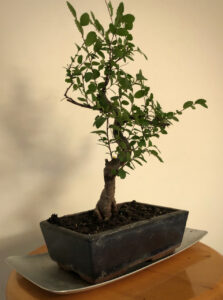
Photo by John Griswold
On a trip to the Missouri Botanical Garden in St. Louis this summer, a wonderful thing happened: my younger son suddenly thought of something he would like for his birthday. My kids do not want things, usually, which makes holiday gift-giving difficult, so I was happy to hear it. We were in the Japanese Garden at the time, a beautiful space, one of the largest in North America, and he said he was interested in getting a bonsai tree. Wonderful.
The tree came from one of the main companies that sell starter kits with your choice of a five- to seven-year old tree “professionally trained” into an S shape and planted in a ceramic bonsai pot, along with the plastic humidity tray under the pot, rocks to put in the tray under the pot, fertilizer, wire for shaping branches, an instruction manual, thinning shears, and all the best wishes for good luck. We were going to need that more than we did thinning shears, since the shears would only be used if the tree lived long enough to need shaping.
I was given a bonsai as a gift many years ago and promptly let it die, which still makes me cringe, both for what I did to the tree and to the gift-giver emotionally. I am sure it was an expensive tree, and possibly relatively old, but my lifestyle, let’s call it, was not right for attention to daily watering and how the sun landed on it as the planet tilted and spun. To my shame, I would have had a better chance of sailing a dingy across an ocean, using a sextant to arrive at my destination, than I did nurturing that tree.
So when my son’s starter bonsai arrived, green, perky, and vital, and quickly showed itself to be infested with some sort of bugs, I was anxious. My son watered it faithfully, put it out of the draft from the vent, and made sure it got sun. But the bugs, which had evolved to look exactly like budding leaves and leaf stems of the Chinese Elm, began to take their toll. Some, and then all but a few, leaves turned yellow and dropped. My son was disappointed. The company told me to spray soapy water on the tree to kill the bugs, and to give it time and keep it watered, but when I sent the latest photos to show them what it looked like, they said they were sending a replacement and to do whatever I wanted with the original—both good customer service and punishment. The tree had one leaf left.
When you watch two dozen YouTube videos of the UK’s bonsai master-grower talking about bonsai and their care, as I did, and pace and peer at your two bonsai on different floors of your home, inspecting them constantly for bugs and signs of fungal growth, cleaning their trays and stands of dead larvae, as I did (and continue to do), it gets serious; you get involved. The trees would not die on my watch, I swore, and they have not. The naked original now has plenty of new growth, including that last leaf, lightly munched, still attached to its twig, and the replacement tree is slowly getting bushier.
I remember looking up, long ago, whether the forced shaping and confinement of bonsai should be thought of as distressing to the plant. The answer seems to be no. The trees would face all manner of natural challenges in the wild and not suffer by them, and it is possible they can live longer, healthy lives in their pots, while giving us a chance to participate in the life process itself—to accept the responsibility for another living thing, to care for it, to meditate on it. In that sense it is like fatherhood, and I may yet succeed at both.
My son enjoys caring for his tree, hearing the soil bubble in the ceramic pot as the water soaks the root ball, watching its shoots open and swell in the solar wind. We are getting there.
